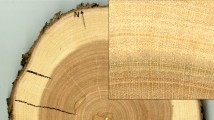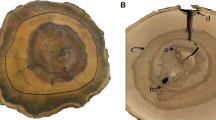Abstract
Weight loss due to fungus Coriolus versicolor has been measured on 614 samples according to the NF EN 113 norm. Up to eight samples were cut at breast height (two opposite radii×four radial positions in heartwood) from 82 mature sessile oaks ( Quercus petraea Liebl.) originating from contrasting regions, silvicultural schedules and site qualities in France. The following points are addressed in the paper: (i) contribution to the total variability for weight loss of the effects “tree”, “position in the tree”, as well as their interaction; (ii) percentage of wood samples and trees in each of the five classes of natural durability defined by the norm NF EN 350–2; (iii) test of the effects of region, silvicultural schedule and site quality on weight loss and evaluating their contribution to the total variation; and (iv) correlations at tree level between weight loss and several traits related to tree growth and basic wood properties (density, swelling, grain angle, multiseriate wood rays characteristics, extractives content). The results are discussed with a view to aid the forest manager as well as the log/wood user to take advantage of the high level of between-tree variability observed as natural durability against C. versicolor.


Similar content being viewed by others
References
AFNOR (1986) Norme NF EN 113: Produits de préservation des bois. Détermination du seuil d’efficacité contre les champignons basidiomycètes lignivores cultivés sur milieu gélosé.
AFNOR (1994a) Norme NF EN 350–1: Durabilité du bois et des matériaux dérivés du bois. Durabilité naturelle du bois massif. Partie 1: Guide des principes d’essai et de classification de la durabilité naturelle du bois
AFNOR (1994b) Norme NF EN 350–2: Durabilité du bois et des matériaux dérivés de bois. Durabilité naturelle du bois massif. Partie 2: Guide de la durabilité naturelle du bois et de l’imprégnabilité d’essences de bois choisies pour leur importance en Europe.
Ayadi N , Charrier B, Irmouli M, Charpentier JP, Jay-Allemand C, Feuillat F, Keller R (2001) Interspecific variability of european oak durability against white rot fungi (Coriolus versicolor): Comparison between sessile oak and pedunculate oak (Quercus petraea and Quercus robur). In: International Research Group on Wood Preservation. International Research Group on Wood Preservation, Nara, Japan
De Groot R, Woodward B, Hennon PE (2000) Natural decay resistance of heartwood from dead, standing yellow-cedar trees: laboratory evaluations. Forest Prod J 50(1):53–59
Dendane A (1996) Analyse de la variabilité de quelques caractéristiques des gros rayons ligneux chez le Chêne rouvre ( Quercus petraea Liebl.). Possibilité d’une estimation non destructive en forêt. Rapport de stage. Document Equipe de Recherches sur la Qualité des Bois, 1996/3, p 74
Dumonceaud O (2001) Petits bois naturellement durables dans des usages extérieurs en vue de limiter l’emploi des traitements par les pesticides: problèmes posés par l’utilisation du Châtaignier ( Castanea sativa Mill.) et intérêts d’un traitement de type friture à basse température. Thèse de Docteur de l’Engref, p 214
Freitag CM, Morrell JJ (2001) Durability of a changing western redcedar resource. Wood Fiber Sci 33(1):69–75
Guilley E, Loubère M, Nepveu G (1999) Identification en forêt de chênes sessiles ( Quercus petraea) présentant un angle du fil du bois intrinsèquement faible. Can J For Res 29(12):1958–1965
Guilley E, Hervé JC, Nepveu G (2004) The influence of site quality, silviculture and region on the wood density-radial growth relationship in Quercus petraea Liebl. For Ecol Manage 189(1–3):111–121
Le Moguédec G, Dhôte JF, Nepveu G (2002) Choosing simplified mixed models for simulations when data have a complex hierarchical organization. An example with some basic properties in Sessile oak wood ( Quercus petraea). Ann For Sci 59(8):847–856
Littell RC, Milliken GA, Stroup WW, Wolfinger RD (1996) SAS system for mixed models. SAS Institute, Cary
Mosedale JR, Charrier B, Janin G (1996) Genetic control of wood colour, density and heartwood ellagitanin concentration in European oak (Quercus petraea and Q. robur). Forestry 69: 111–124
SCEES (1996) Forests and the wood and timber industries. Collection GraphAgri Forêt-Bois, p 150
Snakkers G, Nepveu G, Guilley E, Cantagrel R (2000) Variabilités géographique, sylvicole et individuelle de la teneur en extractibles de chênes sessiles français ( Quercus petraea Liebl.): polyphénols, octalactones et phénols volatils. Ann For Sci 57:251–260
Srinivasan U, Ung T, Taylor A, Cooper PA (1999) Natural durability and waterborne preservative treatability of Tamarack. Forest Prod J 49(1):82–87
Tsoumi G (1991) Structure, Properties, Utilization. In: Reinhold, V. N. (Ed.) Science and Technology of Wood. pp 494, New York
Viitanen H, Paajanen L, Saranpää P, Viitaniemi P (1997) Durability of larch ( Larix spp) wood against brown-rot fungi. International Research Group on Wood Preservation, Document No IRG/WP/97–10228, p 8
Viitanen H, Paajanen L, Nikkanen T, Velling P (1998) Decay of Siberian larch wood against brown rot fungi. Part 2. The effect of genetic variation. International Research Group on Wood Preservation, Document No IRG/WP/98–10287, p 7
Acknowledgements
This study was supported by ADEME and DERF (France) in the frame of a project from “Programme Concerté Bois Matériau” entitled Durachêne coordinated by Dr. Bertrand Charrier of the Ecole Supérieure du Bois in Nantes. The study was carried out with the technical collaboration of André Perrin, Claude Houssement and Marc Doidy (LERFOB)for samples preparation and Nathalie Boizot (Unité Amélioration, Génétique et Physiologie Forestières) for biochemical analyses.
Author information
Authors and Affiliations
Corresponding author
Rights and permissions
About this article
Cite this article
Guilley, E., Charpentier, J.P., Ayadi, N. et al. Decay resistance against Coriolus versicolor in Sessile oak ( Quercus petraea Liebl.): analysis of the between-tree variability and correlations with extractives, tree growth and other basic wood properties. Wood Sci Technol 38, 539–554 (2004). https://doi.org/10.1007/s00226-004-0250-8
Received:
Published:
Issue Date:
DOI: https://doi.org/10.1007/s00226-004-0250-8




